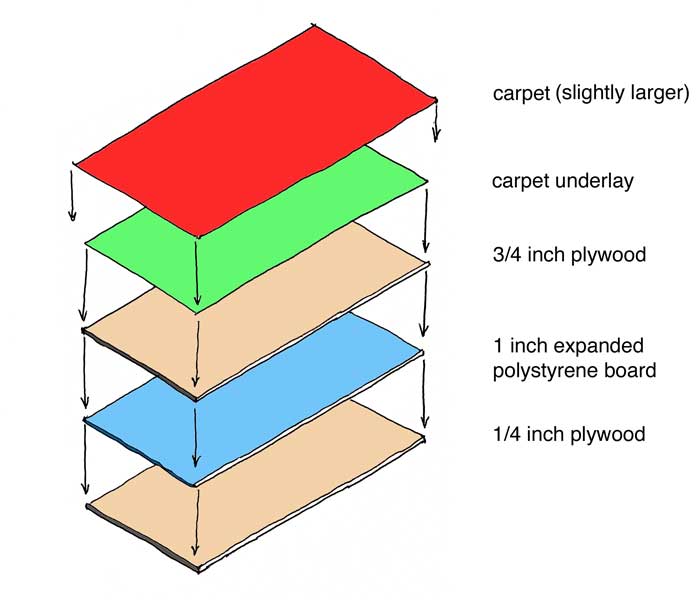Practicing Indian Music, But Not Disturbing the Neighbours

The process of learning Indian music requires practice. It requires a lot of practice! But many people, especially in the US, find that apartment living poses challenges. We will look at the various considerations that affect your ability to practice and not bother your neighbours in these situations. We will start with the cheap and easy things and then move to the more difficult approaches.
Psychology
The first factor to consider is psychology. There are some neighbours for whom you could be playing a bangra dhol at 3:00 am and everything would be fine. But there are others for whom the sound of your toaster ejecting its toast would be enough to elicit complaints. You have to get to know your neighbours. This in itself will solve many problems, because people will be more tolerant of noises coming from friends than total strangers. If you establish a good relationship, you may find that you do not need to do anything else.
Culture
Culture always plays a lot to do with these situations. It is generally considered to be acceptable in the US to make noise between 9:00am to 9:00pm. This is fairly arbitrary, but that is the way it is. Most neighbours will feel hesitant about complaining if you confine your practice to this period. (It may seem silly to even bring this up, but a new immigrant may not find this to be obvious.)
Psychoacoustics
It is important to realise that it isn’t always a question of how loud your practising is, but how loud it sounds. It is very normal for sound to have very different perceived loudness simply due to variations in ambient conditions.
The best example of this is masking. Imagine going out to your garden on a quiet morning and making a cell phone call. Now imagine trying to make the same call in the middle of a rock concert. The cell phone did not become quieter due to the presence of a rock band on stage. But the sound of the cell phone was masked due to the presence of loud ambient noise.
Now apply this same principle to your practice schedule. Determine the schedule that your neighbours follow. If you find that each day at a particular time they like to watch TV, you can be sure that at that time, your practice will have minimum audibility. The sound of their TV will mask your playing.

Where You Play
It is also important to consider the layout of your apartment when deciding where to practice. The problem with most apartment construction is that the walls contain very little mass; so there is not very much to block the sound. You need to consider what else lies between you and your neighbours. Ideally, there should be a whole room between the both of you, perhaps a bedroom or bathroom. Unfortunately, this will not always be the case.

(You are probably thinking about the floor. Hang on, we will save the best for last.)
Acoustical Treatment
OK, so we have exhausted all of the cheap / free ways to deal with the neighbours. It is now time to get serious. It is time for some serious acoustical treatment. This will mean you will have to start shelling out some money. Fortunately, it need not be expensive.
In the next two sections we will be dealing with two approaches. But there is one rule of thumb. PUT AS MUCH MASS BETWEEN YOU AND YOUR NEIGHBOURS AS POSSIBLE! There are numerous variations, such as impedance mismatching, which can allow you to optimise the mass that you do use; but throwing mass at the problem is inescapable.
It is also important to remember that none of these techniques are magic. There will always be some sound passing through. However, they can be remarkably effective at reducing sound transmission.
Walls – If the problem is transmission of sound through the walls, you should look into floor to ceiling bookshelves. They are a very effective way of blocking the sound. They have the additional advantage of providing a nice touch of class to the decor of any apartment. Furthermore, they can be put in with minimal damage to the wall; often with no more than a single screw at the top to keep it from tipping over.

After one has put in the bookshelf, it is important to completely stuff it with as much stuff as you can. These items should have a high mass. Floor to celling books with a couple of inches air gap between the books and the wall are ideal.
Floor -The most common and bothersome problem in apartments is sound being transmitted through the floor below you. Floors, by their very nature, are unfortunately very efficient at coupling acoustical energy into the room below; even the slightest movement can sound very loud to people below you. Still it can be addressed well without spending too much money. For this we will have to build an acoustical isolator.
Here is what we need for an acoustical isolator which is large enough for two people. This should cost about $100:
- 1 inch thickness, 4 x 8 expanded polystyrene insulation board. (i.e., Styrofoam or U-foam). This is roughly $15 at the time of writing.
- 3/4 inch thickness 4 x 8 plywood. The cost of this is highly variable, but at the time of writing $20-$40 is a rough estimate.
- 1/4 inch plywood. (approx $10-$15) (note – you may dispense with this if your floors are not carpeted.)
- Underlay (roughly $40). Shipping blankets are an inexpensive and effective alternative.
- Thick carpet or rug that is larger than 4×8. (The price is highly variable.)
The first thing to do is to select the spot in the apartment as per the previously noted criteria. If the apartment is carpeted, lay down the 1/4 inch piece of plywood. You should have at least a one inch gap around this plywood. It should not touch baseboard, wainscoting, wall, or any item that is in direct contact with the floor. Next, lay down the 1 inch Styrofoam (insulation) sheet. On top of that, place the 3/4 inch plywood.
The acoustical isolator is now functional, but it is aesthetically unpleasant and uncomfortable. Therefore, on top of that we put rugs, blankets, carpet, underlays, or whatever we want. These will give us a surface that is both comfortable to sit on, and attractive to look at. This actually is the most expensive part of the affair, but there is a good chance that you already have these in your apartment.
I think that you will be surprised at how effective this really is.

That is it. I hope these suggestions help.
